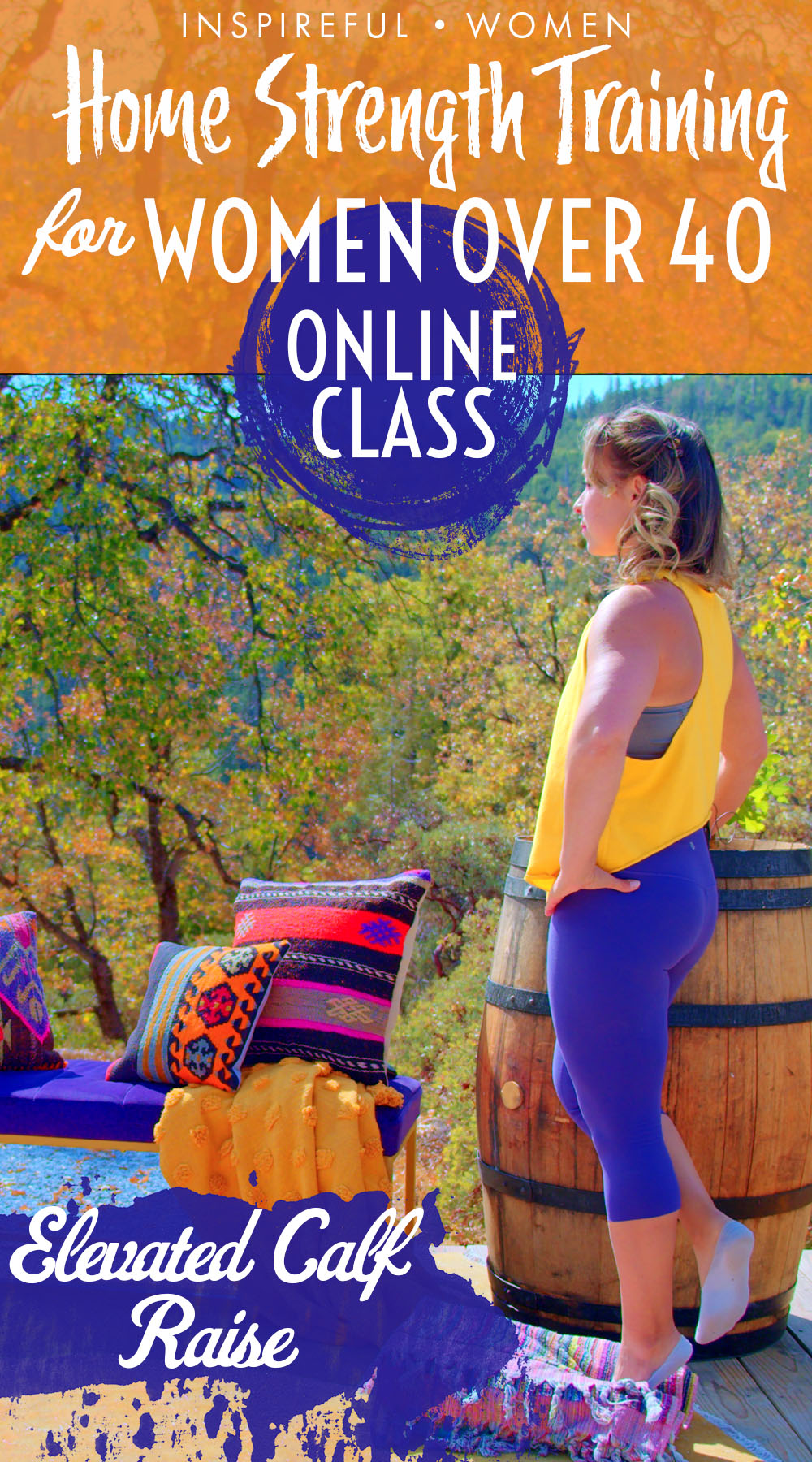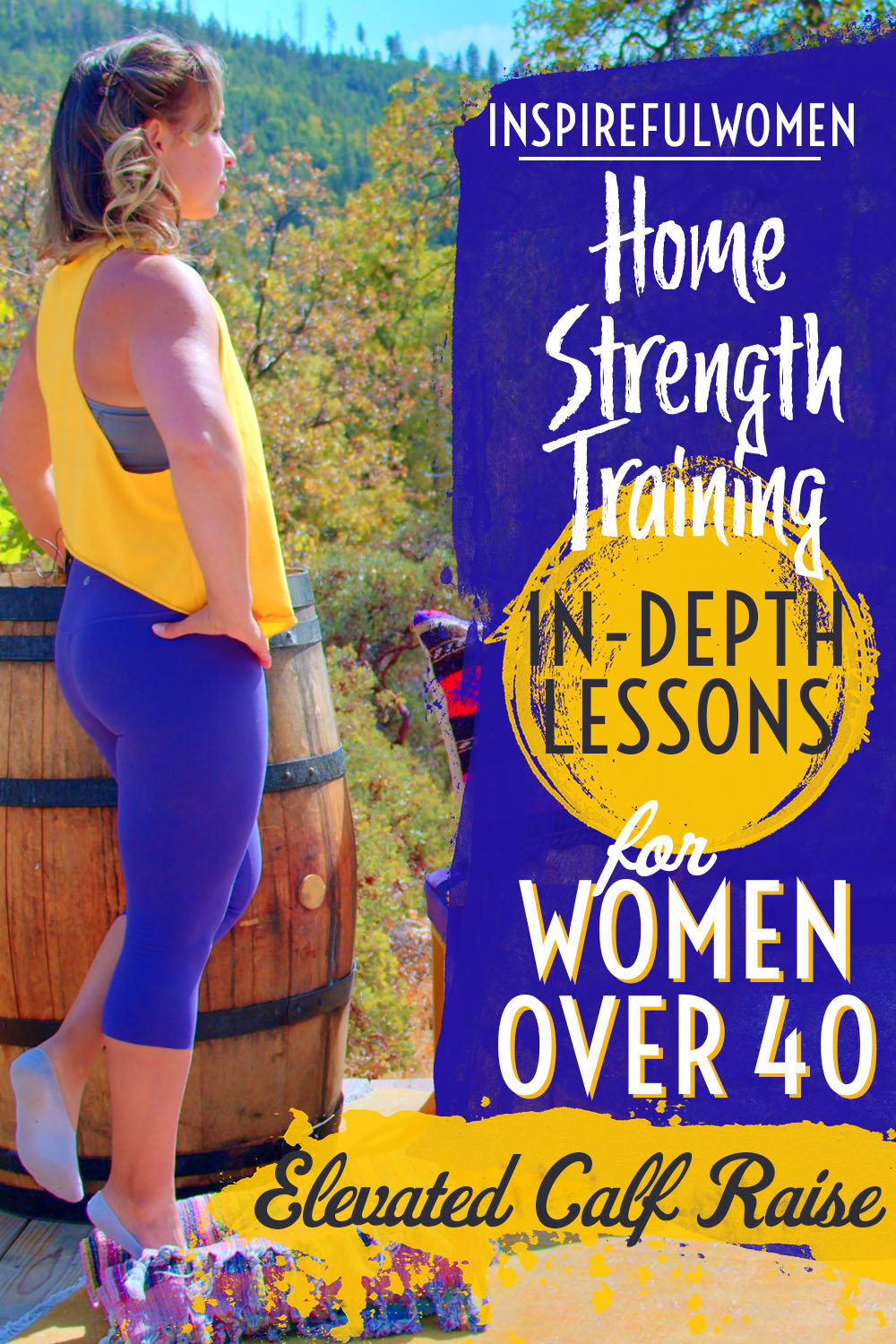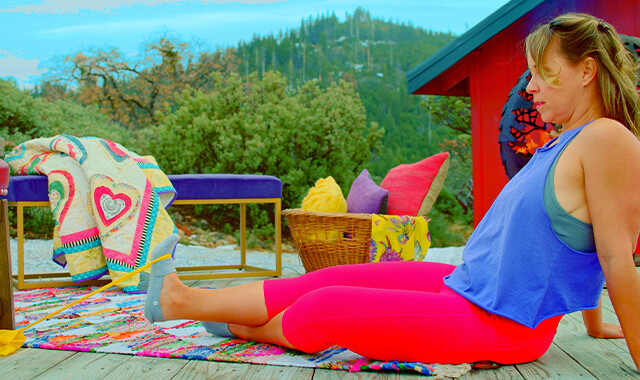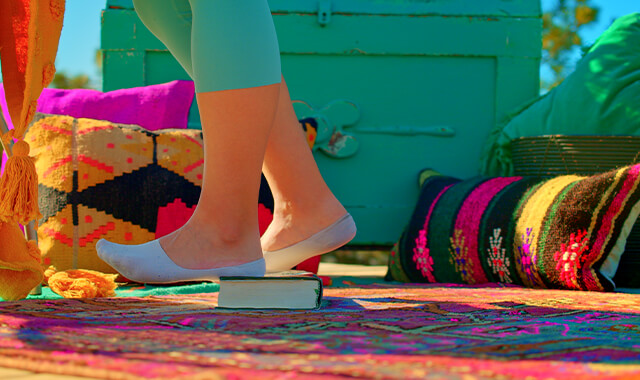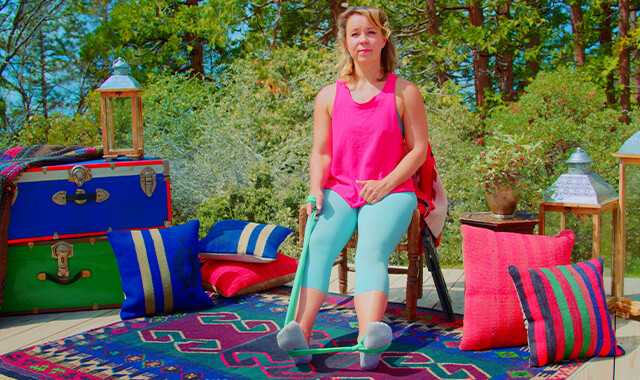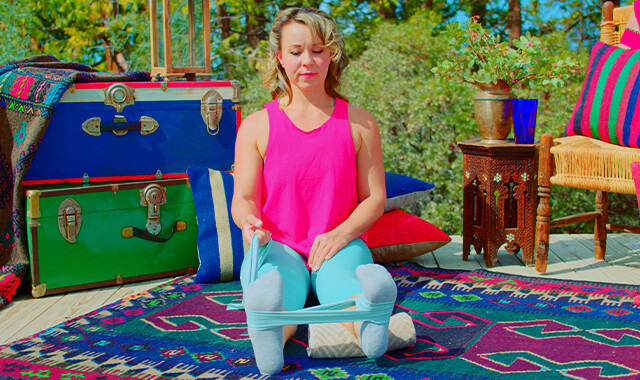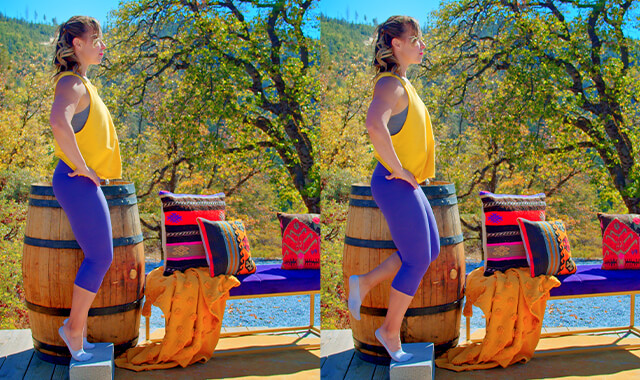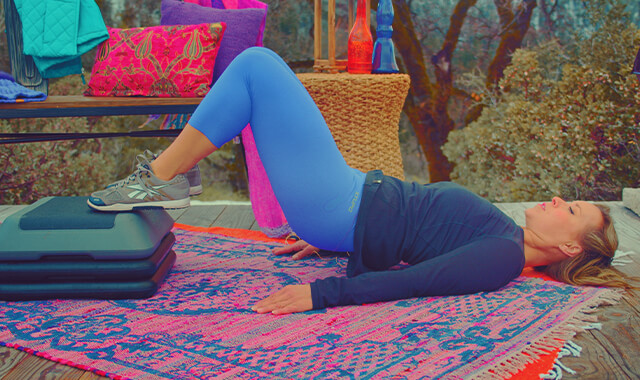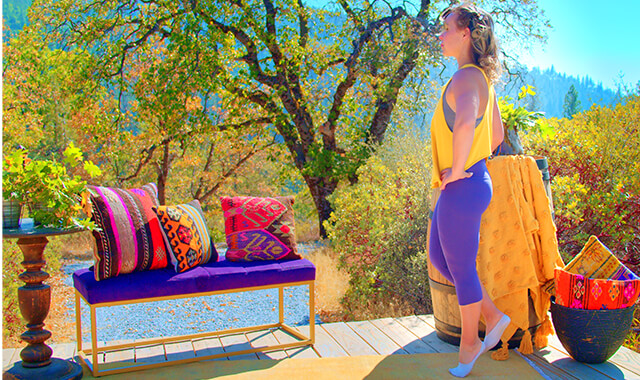Elevated Single Leg Calf Raise
How to Do the Standing Elevated Single Leg Calf Raise - Lower Leg Exercise | In-Depth Guide [VISUAL LEARNERS] Beginner
Proper Form, Common Mistakes, & Variations | Home Resistance Training
WHAT DO YOU WANT TO SEE?
QUICK DEMO
QUICK DEMO
MUSCLES THIS WORKS
MUSCLES
MAIN MUSCLES WORKED IN the Elevated Single Leg Calf Raise
GASTROCNEMIUS & SOLEUS
OTHER MUSCLES WORKED:
- Muscles that also contribute to plantar flexion [pointing foot down]:
- Flexor hallucis longus (calf muscle that also flexes -curls down -the big toe)
- Flexor digitorum longus (also flexes- curls down-toes)
- Plantaris
- Peroneal longus and brevis (also turns the bottom of the foot outward into eversion).
- Intrinsic (small muscles of the foot) muscles that help to move the toes and support the arch of the foot. The muscles of the lower leg work to stabilize the ankle throughout the motion.
STARTING POINTERS
Starting Pointers
ALL WE'RE DOING:
Standing on a book or some such item, push up onto the ball of your foot - like you’ve got super high heels on.
The elevated single-leg calf raise is a simple and convenient exercise that can be performed at home with no equipment. All you need is an elevated surface to stand on and some space to perform the exercise. This lower leg exercise can help to improve balance, coordination, and overall stability.
This variation of the single-leg calf raise is done on a step or stable elevated surface. The ball of the foot is placed near the edge of the step or elevated surface, while the midfoot and heel hang off. This increases the range of motion that the ankle moves through. This is great when you think about say, hiking up a hill, your ankle bends more than if you were on flat ground to help propel you the next step up that hill.
The ankle will start in a dorsiflexed position - meaning that it is bent up - moving the top of the foot closer to the shin, and when you are on the step, the heel is lower than the toes. The calf muscles are responsible for moving the ankle from a position where the toes are higher than the heel to a position where the toes are lower than the heel - pointed down.
When the heel hangs off of the step, dropping down, it stretches the gastroc and soleus muscles. It is thought that stretching muscles and then contracting them from the stretched position helps to build muscle more quickly.
This version not only works the muscles through a larger movement, but it also helps to keep the toes and ankle mobile. Make sure that you push up as high as you can at the top of the movement. Ankle and toe stiffness is a common age-related change that affects how we move, especially walking and going up and down stairs. Even a small decrease in ankle range of motion can have a dramatic effect, causing the hips and back to have to do more of the work. This uses more energy (less efficient) and can cause injury or damage to the joints and soft tissues over time.
The exercise is done on one leg at a time, the calf muscles of one leg will be lifting the entire weight of the body. The calf muscle is very strong and needs to be able to propel the entire weight of the body up. Double-leg calf raises would not challenge the muscles enough unless you were able to hold at weights equal to at least half of your body weight. One leg at a time will also be challenging for your balance and stability of the joints of the foot and leg.
The calf muscles need to be able to contract quickly and strongly for running and jumping, and they need to work at a lower level for a long period of time - for standing, balancing, and walking. It is a good idea to do this exercise at different paces. Quick, explosive push-up, with a slower lowering down and also very slow up and down, with a hold in the stretched position. It is very important to pause at the bottom of the movement when the heel is stretched down. This stretches the Achilles tendon out so that it is less capable of “recoiling” to help lift the body back up, you will need to use the muscles to do the work.
HOW TO DO THE EXERCISE
LOOKS
HOW Elevated Single Leg Calf Raises SHAPE OUR BODY
Tones and shapes the lower legs and ankles.
PROPER FORM
PROPER FORM: Elevated Single Leg Calf Raises
EQUIPMENT, SETS & REPS
EQUIPMENT
Step or stable elevated surface - approximately 4 inches high, but even one inch is helpful - large book, piece of wood, a stack of towels or folded blanket; Barefoot is best for this exercise, or a shoe with a very flexible and flat sole (no heel lift). A wall or counter close by to help with balance when you are up on the ball of the foot.
SUGGESTED STARTING WEIGHT FOR WOMEN:
Body weight.
SETS & REPS:
1-2 sets of 15 reps of bent knees and 15 reps of straight knees
PACE:
Quick/explosive up, hold at the top for 3 seconds, and lower down for a 3-second count, hold at the bottom (stretched) for 3 seconds; or Slow up - 3-second count, hold for 3 seconds, lower for 3 seconds, hold in the stretched position for 3 seconds.
BODY POSITION
BODY POSITION FOR THE Elevated Single Leg Calf Raise
Standing on one foot, on a step. Stand next to a wall or counter to use for balance when you are up on the ball of your foot.
FEET: The ball of your foot is on the step and your heel is off of the step, lowered down as far as it can, and is comfortable. Bend the knee of your other leg to lift your foot up but do not let your lifted leg touch your working leg (this will make it more stable so your leg stabilizers won’t need to work as much).
BODY STANCE: Neutral spine (includes the cervical spine), hips and shoulders squared, knee straight - but not locked, standing by wall to help with balance (wall can be on either side - but in general it is best to have the wall on the opposite side of your working leg - working leg right, wall on left).
HAND/GRIP: Lightly touching the wall to stabilize
ARMS: Other arm (not stabilizing on wall) is by your side, or your hand can be on the top of your pelvis.
HOW TO DO
HOW TO DO Elevated Single Leg Calf Raises
CUE: The movement is straight up and down. Focus on lowering your heels back to the ground very smoothly. Being able to lower your heels down smoothly is a sign of strength and good motor control.
Begin the movement by strongly pushing up on to the ball of your working leg and lifting your heel up as high as you can.
Your body should move straight up. Hold the position at the top for 3 seconds.
Make sure your weight is on the ball of your foot, towards the midline - second and third toe at the top of the movement.
Slowly lower your heel down (3 seconds).
Repeat to complete your reps.
Bend the knee of your working leg - just so that if you look down your knee is over your toes.
Repeat the steps above to complete the reps.
HOW TO SAFELY GET OUT OF THE EXERCISE
Step down off of the step.


COMMON MISTAKES
COMMON MISTAKES
WHAT TO AVOID WITH THE Elevated Single Leg Calf Raise
KEY TIP:
Guess what? Good news! Many avoids are the same for most movements. Once you learn the basics, there's really only a few extra avoids for each individual movement.
1. Avoid Rocking Weight Forward
AVOID: Avoid rocking your weight forward to the ball of the foot.
WHY NOT?
- This is a common error.
- This method uses gravity to shift your center of gravity to the ball of the foot as opposed to using your calf muscle to lift your heel up.
WHAT TO DO:
- Make sure your movement is straight up and that you feel the muscles pulling the heel up.
- Watch the distance between your support surface and your belly (if you are facing the surface)
- When you push up you should not travel forward - you should not get closer to the surface.
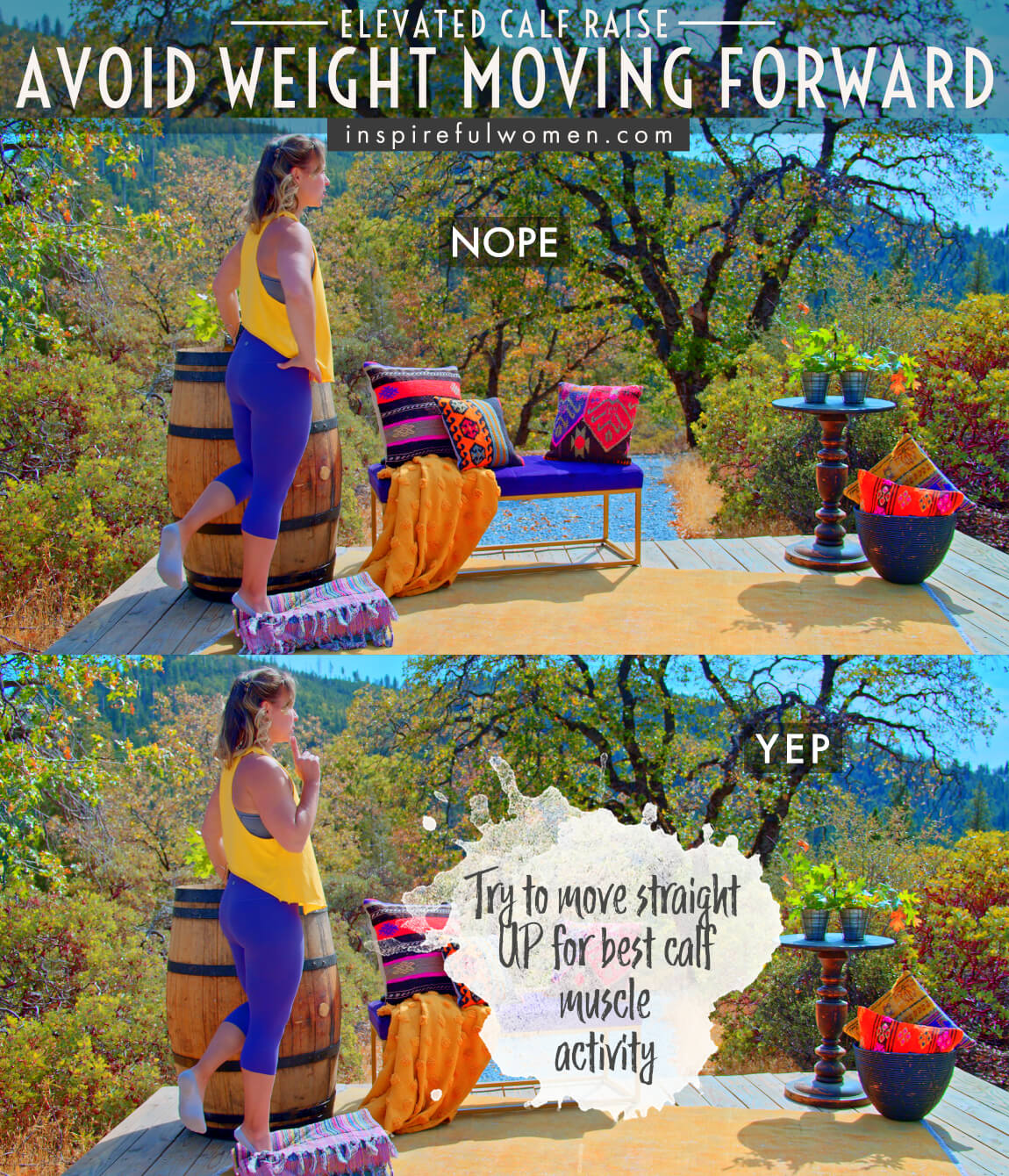
2. Avoid letting your lumbar spine rotate
AVOID: Avoid bouncing.
WHY NOT?
- It is very easy to just bounce up and down.
- Bouncing uses the elastic recoil of the Achilles tendon more than the muscle.
WHAT TO DO:
- Make sure to lift up, and lower down with control.
- Focus on feeling the muscles do the work.
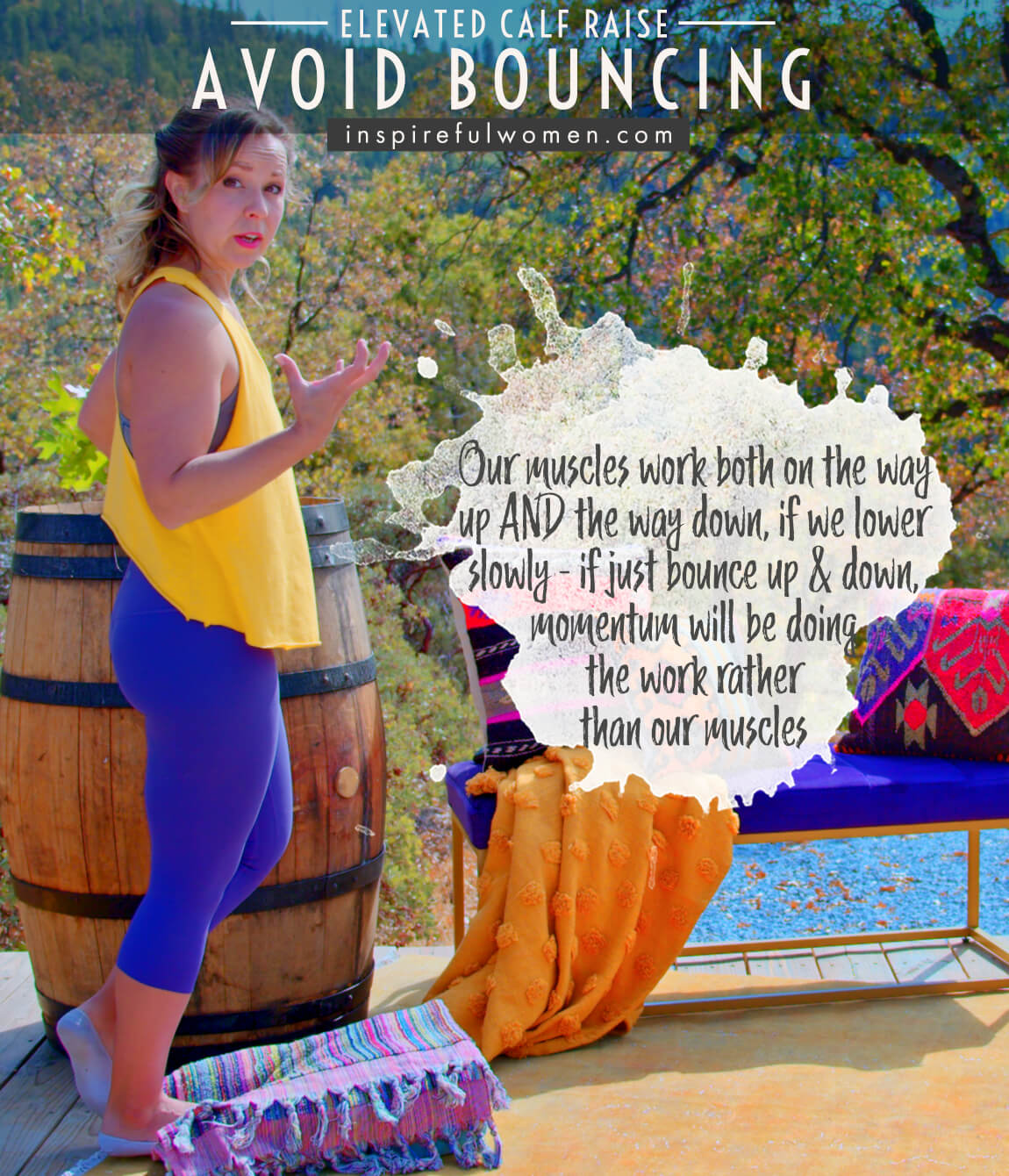
3. Avoid Leaning For Support
AVOID: Avoid leaning on the support.
WHY NOT:
- This can take the weight off of the working leg so that the muscles don’t have to work as hard.
- This will reduce your need to work the stabilizing muscles of the foot, ankle, and leg.
WHAT TO DO:
- Keep your weight directly over the working foot, only making contact with the wall to help with balance as needed to avoid falling.
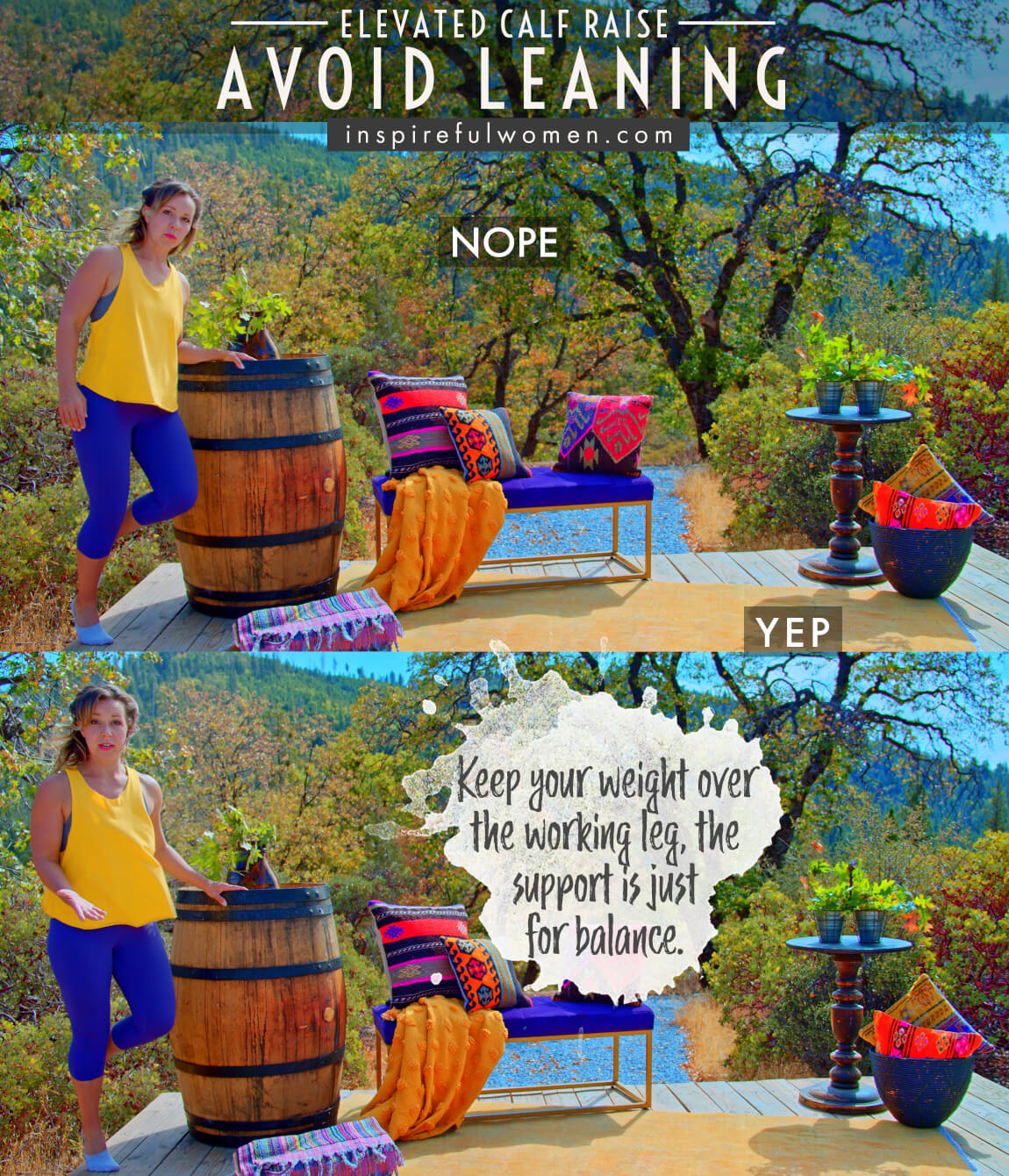
4. Avoid Shifting Weight To Sides Of Foot
AVOID: Avoid shifting your weight to the outside or inside of the foot.
WHY NOT?
- This decreases muscle activity and can strain the ligaments on the sides of the ankle.
WHAT TO DO:
- You should feel the weight distributed across the ball of the foot and anchored around the second and third toe.
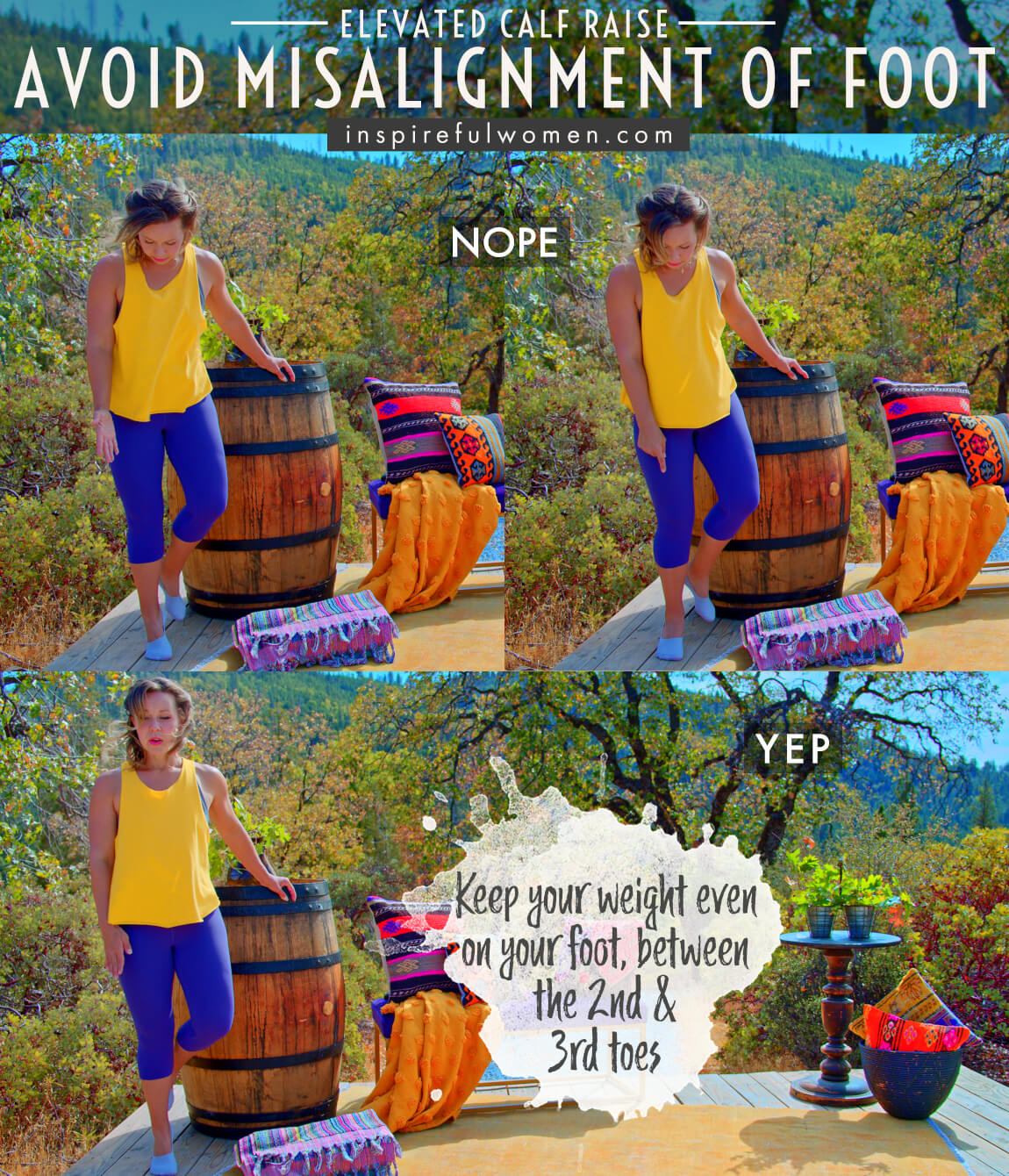
MAKE IT HARDER
HARDER
MAKING THE Elevated Single Leg Calf Raise MORE CHALLENGING
Holding dumbbell
with Dumbbell Elevated Calf Raise
Hold a dumbbell in the free hand to increase the load on the muscles.
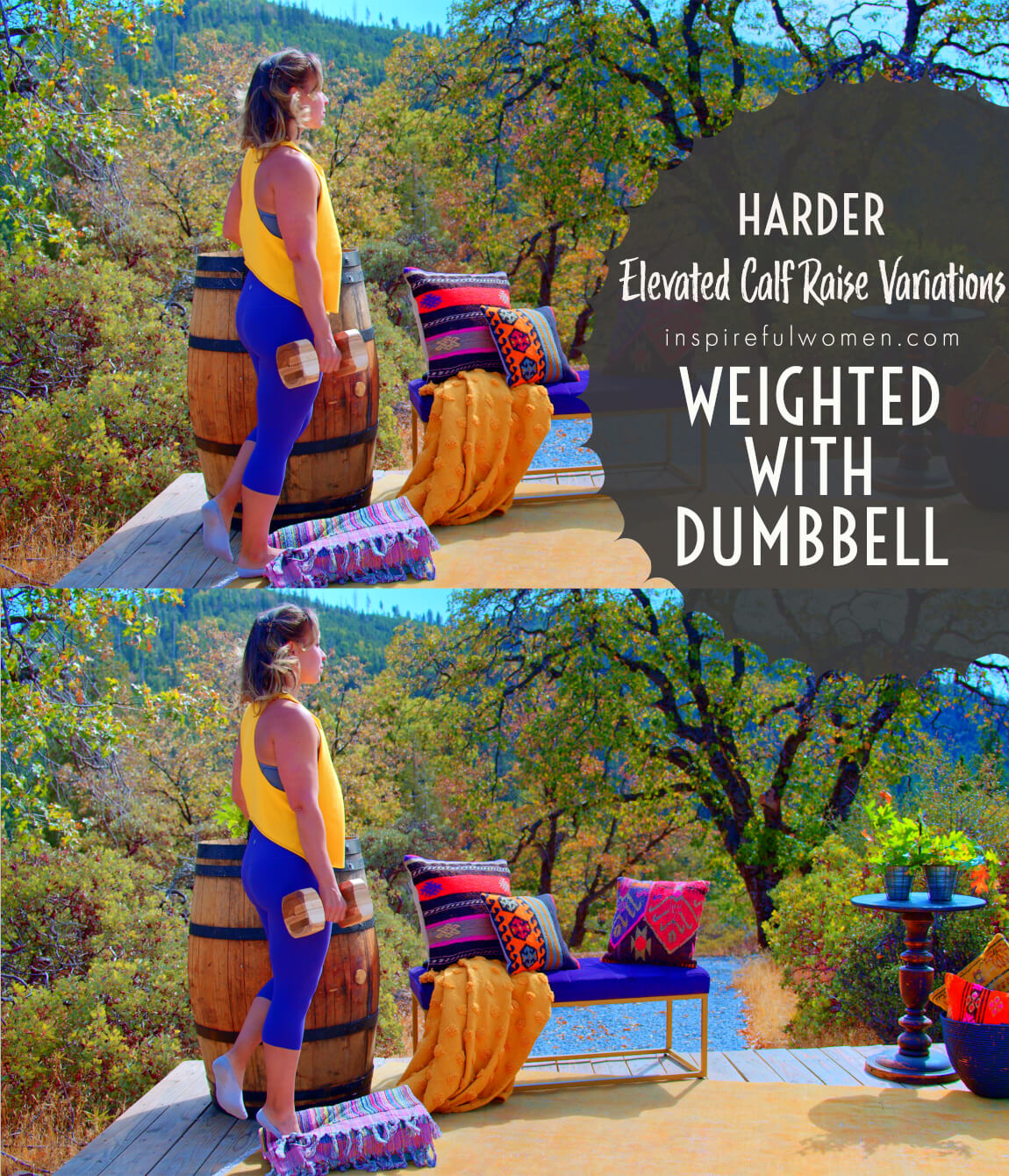
WHAT WE'RE DOING TODAY
WHAT & WHY
BENEFITS OF TRAINING THE Gastrocnemius & Soleus
WHAT
WHAT WE'RE DOING TODAY
Other names for this exercise: Single Leg Heel Lift - Step
These exercises are pretty straightforward and easy to do. The movements use bodyweight for resistance and maybe a dumbbell if you want to get fancy.
The calf muscles work to point the ball of the foot down, like when you push up to your tiptoes. There are two main muscles responsible for this movement - the gastrocnemius (often called the gastroc) is closest to the surface of the calf. The gastroc has two heads, they cross the knee joint and attach on either side of the large thigh bone (femur). The soleus lies underneath the gastroc, it does not cross the knee joint. Both of the muscles form a common tendon, the Achilles tendon, which attaches to the heel. When the muscles contract the heel is lifted up (or toes point down) - however you want to think of it.
The gastroc also crosses the knee joint and can help the hamstrings (a little bit) bend the knee. Both muscles are equally important, and approximately the same size (volume wise).
The exercises that target these muscles involve pushing down with the ball of the foot to lift the heel. To target the gastroc, the knee is kept straight so that the muscle can focus all of its strength on lifting the heel. To target the soleus, the knee is bent. This puts the gastroc into a shortened position over the knee joint, making it less capable of being able to lift the heel, the soleus will do more of the work.
A NOTE ON YOUR FOOT DIGITS
Calf raises require...I bet you have NO idea what I’m going to say next…..good…..TOE range of motion. Yep. Our lives have been reduced (or maybe we’re adding depth? I can’t tell) to considering not just how our toenails LOOK but how much our toes bend.
If you have any limitations in how far your toes can bend back (towards the top of the foot), it might be necessary to limit how far you lift the heel up. It is important to work on the limited range of motion in the toes because you need that for walking. You can do this by bending the toes back with your hands working gently on increasing the movement. This is life in our 40’s, 50’s & beyond right? Instead of the old days when someone asked you what you did over the weekend, you might have said, “went to a party” - now you’re like, “watched my favorite program while bending my toes.” Thrilling. That almost sounds like we’re a baby again. Don’t babies do that? Bend their toes?
The tightness could be due to tight muscles or joints - be careful not to be too aggressive with this. (Somehow the word aggressive & toes going together sounds hilarious to me, but there it is). The joints are small and can be easily irritated if you start forcing them back, especially if you have weight on them.
ANKLE JOINT RANGE OF MOTION:
Many of the versions of the calf raise movement will help increase the range of motion of the ankle joint. Have you dealt with ankle stiffness recently? I have. Increasing the ankle range of motion - increasing the ability to bend at the ankle moving the top of the foot closer to the shin, will help to improve the form for squats, lunges, and climbing up and down stairs. & doing exercises like this one purposefully will help with that a lot.
The gastrocnemius and soleus muscles work hard and fast - for quickly propelling the body forward, for example walking, jumping, and running. They are also posture muscles, they work at a low level at all times during upright posture and to maintain balance while standing still and walking. You can see this aspect pretty clearly when you try to stand on one leg longer than usual, you will notice a lot of the muscles in your lower leg (the area of your leg below your knee) working hard to keep your leg in alignment, your calf muscles included.
It is beneficial to train these muscles in a variety of different ways - for power (heavy load and quick contractions) and for balance and endurance (slow control, longer duration). So that’s what we’re going to do.
WHY BOTHER DOING IT?
WHY
WHY DO WE EVEN CARE?
STANDING DOESN’T NECESSARILY REALLY MEAN “WORKING” IN THE TRUE SENSE OF THE WORD.
The muscles of the lower leg and foot are frequently overlooked during exercise. Most people may think that because they are standing for many of the exercises the lower leg is being used. There is some truth to this. If you are doing a lot of standing exercises without using machines, you are working the muscles of the lower leg to keep the leg and foot aligned, and to stay balanced and stable.
But, we use the muscles of the calf to move our feet during walking, running, jumping, and climbing stairs. When you do these activities, you are actually pointing the toes down to push the ground away from you. It is important to work the muscles through this range of motion.
THE CASE OF THE SHRINKING CALVES
The gastrocnemius and soleus get smaller and weaker with age, the Achilles tendon becomes less effective for transferring force, and the ankle joint loses mobility. The cause and effect probably varies from one person to the next - but the bottom line is that each one of these factors will definitely affect the others.
- If the muscles are weak, they are less capable of moving the joint through its full range of motion which then leads to
- When the joint range of motion is limited, the muscles won’t be worked through the full range of motion which leads to
- the movement will become weaker, which means that,
- Back to #1, the muscle will become even weaker, and so on.
So basically there is a progressive decrease in strength and range of motion.
WHY CARE ABOUT SHRINKING CALVES
These changes affect how you move. Older people tend to walk slower, with shorter steps. They also require more energy to walk. I don’t know about you but I need to use LESS energy, not MORE as I get older. I just have less energy in a day to give than in my 20s. By like a lot. I don’t want to waste it on taking more energy than the average person just to walk. I still got a life to live!
Why does slower shorter steps require more energy? I mean, it seems like it would use less doesn't it? This is thought to be due to the fact that this walking technique is less efficient. When this happens, the calf muscles are not being used to propel ourselves forward but instead we're using the larger hip muscles to pull the leg forward. The bigger muscles use more energy.
Plus here’s the thing I’ve realized at least- I love to take walks outside. Especially in cool breezy weather. Not hot. Yuck. But my energy level & how easy or hard walking feels that day has a direct bearing on how I feel about being out there walking- do you feel like that? On days when my energy is good and my legs feel strong & capable- that whole “hey my legs are propelling me up the hill & it’s not super hard!” - then I’m loving my walk. I feel positive.
But I also have days because of my chronic illness & occasional physical injuries that flare up, where walking both down and uphill feels very hard- each step is quite an effort. I don’t feel like any propelling is going on at all. It feels like everything I have in me is having to be THROWN with all my might at each step- walking does not feel pleasurable on those days. & I feel super bummed out.
So training our legs to be capable with walking can really enhance our quality of life & cause us to want to do more active things that we might otherwise skip out on a lot more often because they feel hard & therefore unpleasant.
WATCHING OUT FOR FALLING IS NOW A THING.
Ankle strength and mobility are very important for staying upright and balanced. When you lose strength and mobility in the lower leg it increases the risk for falling.
BECAUSE IT’S ALL CONNECTED, ALIGNMENT OF THE REST IS AFFECTED BY FEET & ANKLES
Another frequently overlooked fact is that the feet and ankles can dictate the alignment of the legs, back and even neck. The feet have been called the roots of the body. They are responsible for transferring the forces from the ground all the way up with every step you take. Keeping the muscles and joints of the feet and ankles healthy can help the whole body stay healthy and injury-free.
CALF EXERCISES DO ADDRESS THESE ISSUES
The good news is that if you do the right exercises, you can slow or prevent these changes. One of the best things about adding calf exercises is that you develop an awareness of the muscles. You will begin to notice how powerful they are as you walk and climb stairs. You may find that you have a little bounce in your step and you feel lighter on your feet.
GET MORE BLOOD BACK TO YOUR HEART
Calf muscle activity helps to pump the blood from the legs back up to the heart. In fact, sometimes the calf muscles are called “the second heart” or “the peripheral heart”. When the muscles contract they push the blood back up towards the heart.
EVERYDAY LIFE
EVERYDAY LIFE &
MUSCLE FUNCTION
HOW WE USE OUR calf MUSCLES IN EVERYDAY LIFE
1. THE CALF MUSCLES PULL THE FRONT OF THE FOOT DOWN (PLANTAR FLEXION)
- Walking, running, jogging, jumping
- Propels the body forward/up when the leg pushes off of the ground
- Walking on tiptoes
- Standing on tiptoes to reach a high shelf
- Pushing on the gas pedal - quick story about this. My Yiayia (grandma) was a small very energetic woman. I remember one time when I was like 16 years old, I had plans to spend the afternoon shopping with her at the mall. She was driving & as we hurtled down the wide streets of where they lived I saw she was quite a fast little driver. Maybe not so much fast but quick. When we pulled into the mall parking lot, she would floor the gas pedal even for small motions like turning to pull into the parking space she found and then slamming on the brakes. I feel like she had more energy at 70 than I have at 40, but she must have had great calf muscles too from all the Greek dancing she did. 😉 Maybe calf raises should come with a warning label - be careful of driving speed when strengthening your calf muscles. Speeding tickets may ensue.
2. WHEN THE FOOT STAYS PLANTED ON THE FLOOR THE GASTROC/SOLEUS PULL THE LOWER LEG BONE (TIBIA) BACK
- Walking upstairs - the foot on the step
- As it lifts the body weight up to the step the gastroc/soleus pulls the lower leg bone back. In this case
- Transitioning from sit to stand
- Coming up from a squat
3. WORKS WITH THE OTHER MUSCLES OF THE LOWER LEG FOR BALANCE AND ANKLE JOINT STABILITY
- Standing
- All upright activity
4. THE GASTROCNEMIUS ALSO CROSSES THE KNEE JOINT AND CAN HELP THE HAMSTRINGS BEND (FLEX) AND STABILIZE THE KNEE
HOW TO FEEL WHAT MUSCLE IS WORKING
How to Feel What Muscle is Working
Sit in a chair with the knee bent and the foot flat on the floor. Bend forward and place your hand on your calf about halfway down between the knee and the ankle. Push down into the floor with the ball of your foot, lifting your heel off of the floor. You should feel the soleus muscle contract under your hand.
Move your hand up a few inches so that it is on the largest part of your calf. Straighten your knee. Strongly point your toes. You should feel the gastrocnemius muscle contract under your hand.
SCIENCY STUFF
SCIENCY STUFF
SPIFFILICIOUS FACTS ABOUT MUSCLES & MOVES
The “ankle joint” is actually made up of many different joints, it is a very complex structure made up of many bones and ligaments. All of the muscles of the ankle and foot cross more than one joint. Slight changes in the position of the foot can change the action of the muscles.
In standing, with good posture, our center of gravity lies just in front of the ankle joint. This puts a slight forward lean on the body - increasing the dorsiflexion of the ankle. The soleus muscle works to hold the body back (holds the lower leg back against gravity pulling the body forward) constantly when we are just standing upright.
The gastrocnemius originates on the end of the femur. The gastroc has two heads, one attached to each of the femoral condyles. The soleus muscle originates on the tibia and fibula. The gastroc-soleus (sometimes referred to as the triceps surae), form a common tendon, the achilles tendon, which inserts on the calcaneus, or heel. The gastroc and soleus are the primary plantar flexors of the foot. The muscles also attach to the talocalcaneonavicular joint (located towards the inside of the foot) and can supinate the rear part of the foot and elevate the arch of the foot.
During walking, the gastroc-soleus complex works both eccentrically and concentrically. When the back leg is brought forward (swing phase) and the heel touches down to the ground, the muscles work eccentrically to control the foot as it lowers down to be flat on the ground. The gastroc-soleus complex continues working as the weight is loaded onto the leg. Once the leg passes behind the body, the muscles work concentrically to push off of the ground and propel the body forward.
Muscles that also contribute to plantar flexion [pointing foot down]: Flexor hallucis longus (calf muscle that also flexes -curls down -the big toe), flexor digitorum longus (also flexes- curls down-toes), plantaris, tibialis posterior (also inverts and adducts the foot) peroneal longus and brevis (also turns the bottom of the foot outward into eversion). These are weak plantar flexors - they really won’t contribute very much unless the load is very heavy or the duration of the movement is very long.
Calf raises will also involve the Intrinsic (small muscles of the foot) muscles that help to move the toes and support the arch of the foot. The muscles of the lower leg work for balance and to stabilize the ankle throughout the motion.
ALL MUSCLES & WHEN
ALL MUSCLES WORKING & WHEN DURING THE Elevated Single Leg Calf Raise
This exercise is completed in two positions - knee straight and knee bent. When the knee is straight the gastrocnemius does most of the work to lift the heel up (concentric contraction) and point the foot down {plantar flexion). The gastrocnemius works eccentrically to lower the heel back down.
When the knee is bent the soleus muscle works concentrically to lift the heel and point the foot down (plantar flexion), and eccentrically to lower the heel back down.
The muscles that cross the ankle, knee and hip will be active throughout the exercise to stabilize the working leg.
The plantaris, flexor hallucis longus, flexor digitorum longus,and peroneal longus and brevis are very weak plantar flexors that may help out, especially if the load is heavy or the duration of the exercise is longer (the gastrocnemius and soleus have fatigued).
PIN IT FOR LATER!
